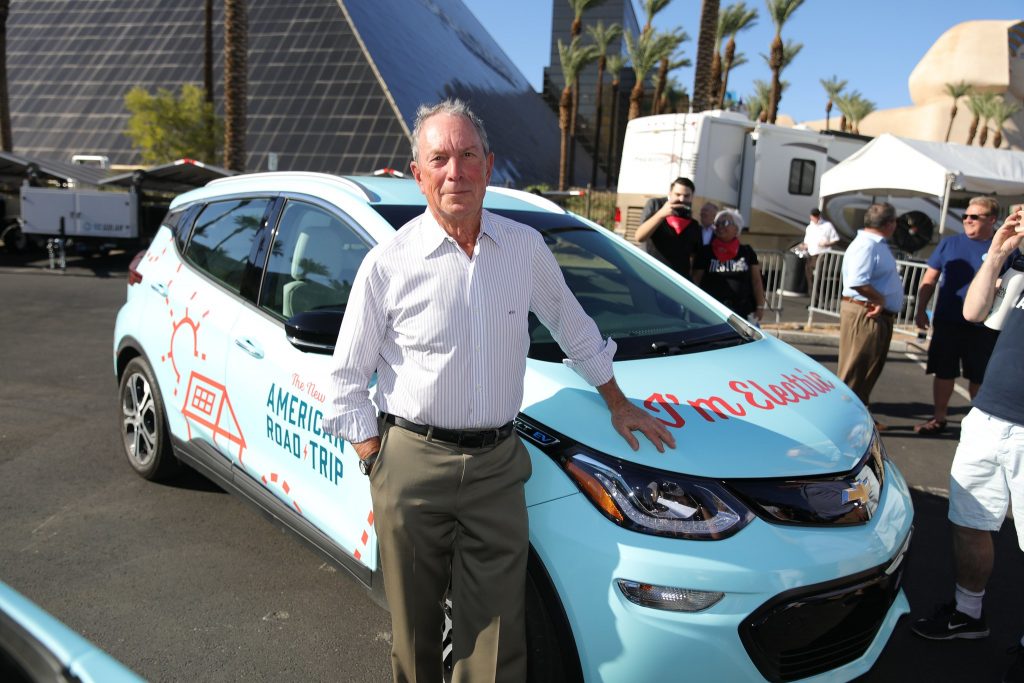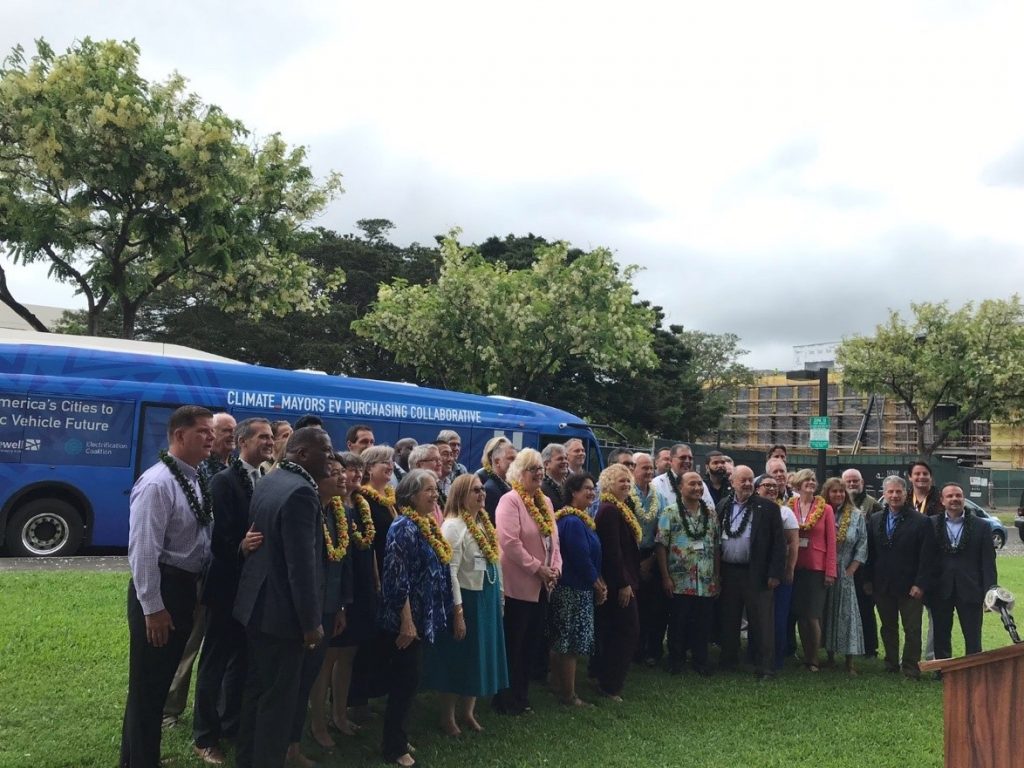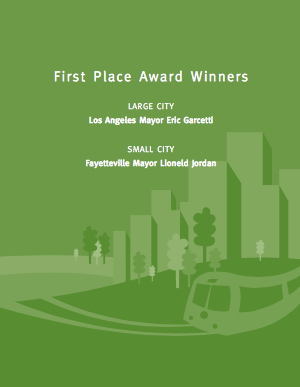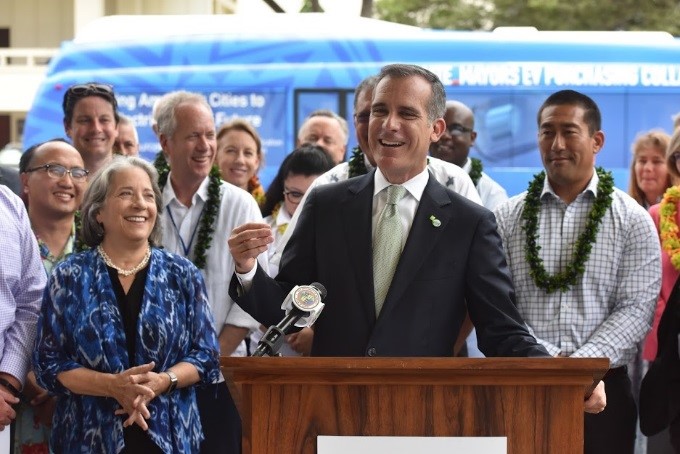American Cities Drive Fleet Electrification Efforts Across United States

By Ben Prochazka, Vice President of the Electrification Coalition
In recent years, the transportation sector has become the leading source of greenhouse gas (GHG) emissions in the U.S., accounting for approximately 29 percent of total annual emissions. [1] Additionally, the transportation system is a major contributor to increased air pollution that negatively impacts our health – and, with the volatile nature of our oil markets, oil’s monopoly on our transportation sector also threatens our economy. The problem is clear: a gas-guzzling transportation sector presents risks to our economy, public health, and environment.
 Thankfully, huge advances in technology are providing a path to a new transportation future. The widespread electrification of vehicles will greatly reduce our reliance on oil, slash carbon emissions, and improve public health. In addition, the switch to electric vehicles (EVs) will also save money for consumers and municipalities, because EVs cost less to operate and maintain.
Thankfully, huge advances in technology are providing a path to a new transportation future. The widespread electrification of vehicles will greatly reduce our reliance on oil, slash carbon emissions, and improve public health. In addition, the switch to electric vehicles (EVs) will also save money for consumers and municipalities, because EVs cost less to operate and maintain.
The growth of EVs in the U.S. has been impressive. With the hard work of advocates, cities, states, and champions in the private sector, there are already more than one million EVs on the road. But with over 250 million light duty cars[2] and trucks on the road, it is going to require more investment and new strategies to rapidly accelerate EV adoption.
U.S. Cities are Leading the Way with Fleets
Last month (June) at the 87th Annual U.S. Conference of Mayors Meeting in Honolulu, HI, fleet electrification in cities took center stage. The Climate Mayors Electric Vehicle Purchasing Collaborative (the Collaborative) showcased incredible growth in the past year, highlighting the expanding number of cities and commitments made to purchase EVs for their municipal fleets. The U.S. Conference of Mayors also unanimously passed a resolution committing to fleet electrification and calling on more cities to transition their fleets to EVs.
Hitting New Milestones for Fleet Transition
During the Climate Mayors Summit, the Collaborative announced that 127 cities and 15 counties from across 38 states have committed to purchasing more than 2,100 EVs by the end of 2020. The Collaborative is building on this success by looking to recruit additional cities to make bulk commitments to electrification. To do so, the Collaborative has created a platform that will ensure cities follow through with these commitments by making it cheaper and easier to go electric.
The commitments made by these cities and counties to transition their fleets to electric will have a significant impact by:
- Cutting gas usage by up to 1 million gallons each year;
- Transitioning to 25 million electric miles driven each year; and
- Adding more than $75 million in purchasing power to the electric vehicle market[3].
The Collaborative also announced plans to place a competitive bid on electric school buses by the end of this year, which will enable all electric school bus manufacturers to offer any public school system in the country access to equal, competitive bus prices. With more than 480,000 school buses operating across the country, this represents an enormous potential to both decrease transportation emissions associated with traditional school buses, and provide educational opportunities for students.
The announcement in Hawaii showed the continued expansion of the program—growing the number of cities making near term commitments to electric options and expanding the program to meet the expanding interests of fleets. With the future addition of buses and school bus options to the platform, we’re excited to bring even more electric vehicle options to our platform to ensure the program evolves to both accelerate electric vehicle deployment and meet consumers’ needs.

The Collaborative Wins Award
 During the Annual Meeting, Los Angeles Mayor Eric Garcetti received the top large City award at the 13th annual Mayors’ Climate Protection Awards. This award recognized Los Angeles’ work in helping to establishing the Collaborative. According to the awards’ overview, “Currently, Los Angeles has approximately 800 electric vehicles in its municipal fleet, which saves $220,000 in fuel costs and reduces approximately 1,170 metric tons of carbon dioxide annually. Decarbonizing all of L.A.’s on-road transportation by 2050 will reduce 36 million tons of greenhouse gas emissions and prevent 980 premature deaths and 400 respiratory and cardiovascular hospital admissions annually, saving $9.5 billion in reduced health care costs.”
During the Annual Meeting, Los Angeles Mayor Eric Garcetti received the top large City award at the 13th annual Mayors’ Climate Protection Awards. This award recognized Los Angeles’ work in helping to establishing the Collaborative. According to the awards’ overview, “Currently, Los Angeles has approximately 800 electric vehicles in its municipal fleet, which saves $220,000 in fuel costs and reduces approximately 1,170 metric tons of carbon dioxide annually. Decarbonizing all of L.A.’s on-road transportation by 2050 will reduce 36 million tons of greenhouse gas emissions and prevent 980 premature deaths and 400 respiratory and cardiovascular hospital admissions annually, saving $9.5 billion in reduced health care costs.”
Passage of U.S. Conference of Mayors EV Resolution
The Collaborative also worked to unanimously pass an official resolution through the U.S. Conference of Mayors to encourage the accelerated adoption of EVs. The resolution emphasized the risks of our nation’s transportation sector’s overreliance on oil for transportation, underscoring the climate, public health, and economic benefits of fleet electrification.

Why Fleet Electrification?
Electrification of the transportation sector has incredible societal, economic and national security benefits, and fleets are well positioned to maximize the benefits of going electric. Fleets are optimized and tracked every day to help understand performance and cost—meaning that while some EVs still have a higher upfront purchasing price, the total cost of ownership (TCO) can be significantly lower, especially in fleet settings. Additionally, EVs in fleets save money over their lifetime because they cost less to fuel and maintain: Gasoline prices have ranged from almost $4 per gallon in May 2011 to around $2.75 today; electricity has hovered around a price equivalent to $1 per gallon. Fleets also have the benefit of route predictability, making it easy to prioritize the right operational profile for EVs—and since fleets often park in a centralized location at the end of their shift, there are lower infrastructure costs. Fleets also tend to be higher-mileage vehicles than consumer cars, which means that the business case for EVs will be realized sooner. Finally, EVs are a great solution for an agency or government with a sustainability plan: They rely on a domestic and diverse source of energy that is cheaper than petroleum, and with that comes reduced GHG emissions.

Fleet Transition Can Have a Snowball Effect
There are approximately 8.5 million fleet vehicles under operation in the private and public sector across the country.[4] Fleet vehicles are heavily used, representing a significant opportunity for cities to precipitate a shift away from oil-based fuels in the transportation sector. Electrification of fleets not only replaces internal combustion engine vehicles, but also presents the opportunity to educate drivers on the benefits of transitioning to electric and, as scale is achieved, increase overall public awareness of electric transportation.
By working with cities and other public agencies across the country, the Electrification Coalition and our partners with the Collaborative are helping the transportation electrification movement gain momentum and revolutionize the way we get around. Thanks in large part to Bloomberg Philanthropies, we’ve made great strides – and today’s progress is just the beginning.
About the Climate Mayors EV Purchasing Collaborative
The Climate Mayors EV Purchasing Collaborative, supported by Bloomberg Philanthropies, assists cities and municipalities to electrify their fleets by reducing the costs and barriers associated with EV purchasing. In agreeing to purchase electric vehicles through the Collaborative, municipalities and public agencies gain access to competitively solicited electric vehicles and charging infrastructure, as well as leasing options that can monetize state and federal tax credits. The Collaborative also provides cities with staff and tools to provide fleet electrification technical support. More information can be found online about the Collaborative at http://driveevfleets.org. You can continue following this series to learn more as the program continues electrifying our nation’s fleets.